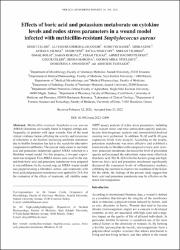Effects of boric acid and potassium metaborate on cytokine levels and redox stress parameters in a wound model infected with methicillin‑resistant Staphylococcus aureus

Göster/
Tarih
2022Yazar
Çelebi, DemetTaghizadehghalehjoughi, Ali
Başer, Sümeyye
Genç, Sıdıka
Kordali, Şaban
Yılmaz, Ferah
Üst veri
Tüm öğe kaydını gösterKünye
Celebi, D., A. Taghizadehghalehjoughi, S. Baser, S. Genc, A. Yilmaz, Y. Yeni, F. Yesilyurt, et al. 2022. "Effects of Boric Acid and Potassium Metaborate on Cytokine Levels and Redox Stress Parameters in a Wound Model Infected with methicillin‑resistant Staphylococcus Aureus." Molecular Medicine Reports 26 (3). doi:10.3892/mmr.2022.12809Özet
Methicillin‑resistant Staphylococcus aureus (MRSA) infections are usually found in hospital settings and, frequently, in patients with open wounds. One of the most critical virulence factors affecting the severity and recurrence of infections is the biofilm; increasing antibiotic resistance due to biofilm formation has led to the search for alternative compounds to antibiotics. The present study aimed to use boric acid and potassium metaborate against MRSA infection in a fibroblast wound model. For this purpose, a two‑part experiment was designed: First, MRSA strains were used for the test, and both boric acid and potassium metaborate were prepared in microdilution. In the second step, an MRSA wound model was prepared using a fibroblast culture, and treatments with boric acid and potassium metaborate were applied for 24 h. For the evaluation of the effects of treatment, cell viability assay (MTT assay), analysis of redox stress parameters, including total oxidant status and total antioxidant capacity analyses, lactate dehydrogenase analysis and immunohistochemical staining were performed. In addition, IL‑1β and IL‑10 gene expression levels were assayed. According to the results, potassium metaborate was more effective and exhibited a lower toxicity to fibroblast cells compared to boric acid; moreover, potassium metaborate decreased the level of prooxidant species and increased the antioxidant status more effectively than boric acid. The IL‑1β level in the bacteria group was high; however, boric acid and potassium metaborate significantly decreased the expression levels of inflammatory markers, exhibiting the potential to improve the resolution of the lesion. On the whole, the findings of the present study suggest that boric acid and potassium metaborate may be effective on the tested microorganisms

















